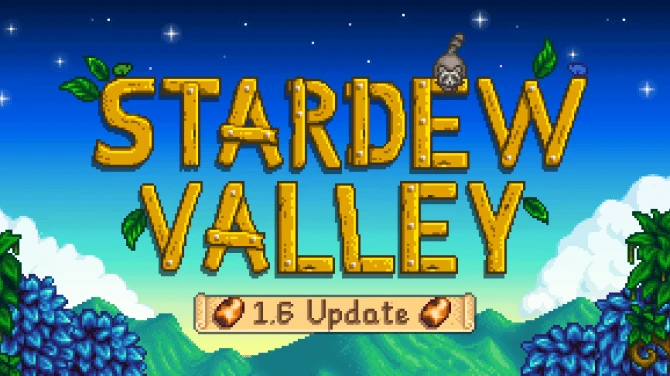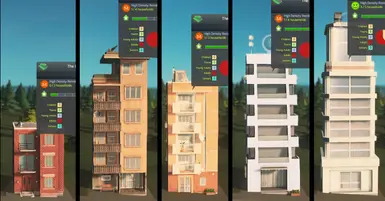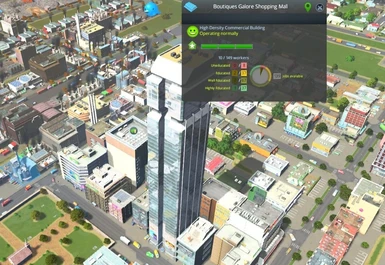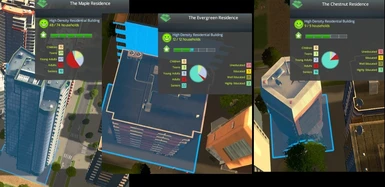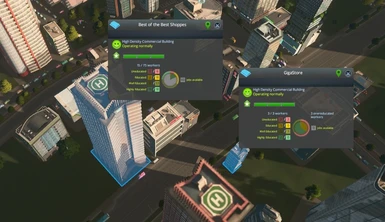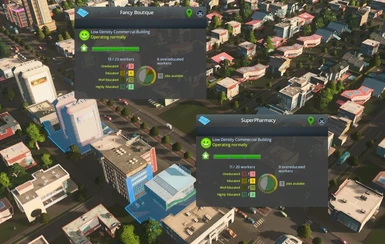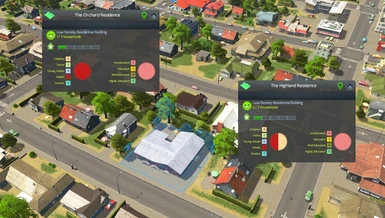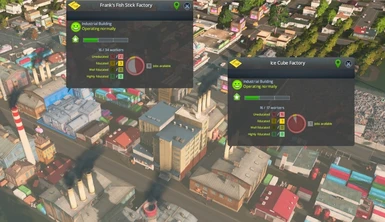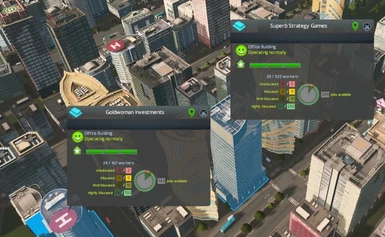About this mod
Looking for a more realistic simulation and gameplay experience? Sick of having half-a-dozen families crammed into a single suburban house, while tall apartment buildings only contain a ridiculously small number of households? Tired of empty downtowns because all your office buildings have only a handful of workers?
Want buildings to mor
- Permissions and credits
This mod is not (currently) recognised by the original Ploppable RICO mod. Please use Ploppable RICO revisited instead.
What this mod does - basic overview
This mod changes the numbers of households and jobs in buildings to more
accurately reflect real-world values. Detatched surburban housing will
typically only support one family, while high-density residential
buildings will have a number of households calculated based on the size
of the building. A small unit block might only have six households,
whereas a taller one might have dozens (or even hundreds with large RICO
buildings when using the Ploppable RICO Revisited mod). Office
buildings and other employers support significantly more workers than
the very low base game numbers; a single downtown skyscraper can now
support hundreds of jobs, not just 12! This results in a much more
realistic ratio of residential to commercial, industrial, and office
buildings, and enables the natural evolution of more realistic downtowns
and suburbs.
Employment values based on education levels are also changed to more accurately reflect real-world requirements and to
help address some of the base game's shortcomings in this area. Office
jobs are more heavily focussed towards your college graduates, and
commercial and industrial jobs will require a higher ratio of
high-school leavers than in the base game. This requires a more
realistic level of investment in your education infrastructure.
Production of goods, water and electricity consumption, garbage accumulation, and
building income have all been tweaked accordingly.
Finally, tax income is now affected by land values. Raising land value, for example
by placing parks, now increases your tax income.
These changes make decisions around density, zoning, and infrastructure more
meaningful and more akin to the real-world tradeoffs. Low-density
housing will provide lower population density than in the base game,
meaning that sprawling suburbs will have more of their real-life
downsides. Conversely, higher-density areas will have much greater
population and job density than in the base game, meaning that you'll
need to ensure that you have the appropriate transportation
infrastructure in place to support this density.
Ideally used in conjunction with Lifecycle Rebalance Revisited, but also works standalone. If you're using the Industries DLC, the Rebalanced Industries mod is strongly recommended (but not required).
What this mod does - more detail
By default, all low density residential buildings are set to have only one
household unless this is overridden in the building's settings.
Default overrides are already in place for some vanilla assets (so
duplexes/semi-detached houses will have two households).
For workers and high density residential buildings, the number of
jobs/households is determined by the volume of the building (width x
length x height as determined by construction scaffolding). Power and
water consumption values are based of the real-world values of Perth,
Western Asutralia and scaled for the game.
Demand impacts
Athough this mod doesn't touch demand (Residential/Commercial/Industrial)
directly, the changed game balance means you might see some different
demand patterns than you're used to with the vanilla game, especially
with industrial demand. See this page on the wiki[github.com] for more details.
Warning
Due to the significant changes to the base game, this mod is best used for new games only. You can use it on an existing game, but be warned that it will
significantly affect the balance of your city - most likely you'll see
significant abandonment of factories, shops and offices (due to their
more realistic job numbers), your transport infrastructure may be
overloaded in high-density areas, and you may have land value issues.
Your city can be rebalanced with appropriate zoning and transportation
adjustments.
New games started with this mod can now follow a more natural progression from low to high density than in the base game,
but note that use of space needs to be carefully managed through the
early stages if you are sticking to the base game's area unlocking
progression, as the average city density when starting out with this mod
will be lower than in the base game. You'll probably also want to hold
off zoning much high-density until you've got some decent
transportation infrastructure in place.
Mod configuration
Everything this mod does configurable. Don't like the default assumptions? Change them!
Configurations can be changed by using the mod's options panel, or by editing the WG_RealisticCity.xml file[github.com] (100% backwards compatible, so your existing configurations from the original mod will still work).
Having difficulty?
- Ensure that the mod is activated in your content settings.
- Ensure that you understand the basics of using mods for Cities:Skylines (starting with this guide by AquilaSol – especially the bit about always quitting to the desktop between loads)
- Check that you’re not running with any outdated/conflicting mods.
- If problems still persist after that, please leave a comment (preferably
including a link to your output.log) and I’ll see if I can help.
Comments are actively curated in order to keep the comments section useful and relevant to others.
Credits
Obviously, huge amounts of credit to Whitefang Greytail, the creator of the
original Realistic Population and Consumption Mod. In turn, that mod
started out as a fork of Kundun's PopBalanceMod.
This mod uses Harmony[github.com] version 1.2.0.1, by Andreas Pardeike[github.com].
Source available on GitHub[github.com].







